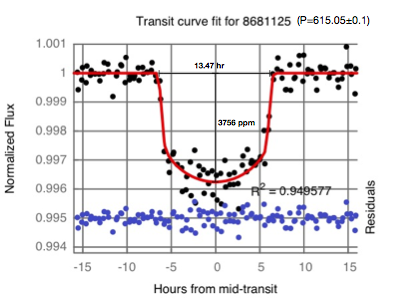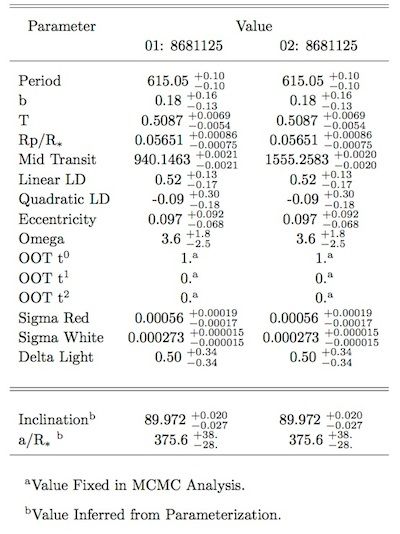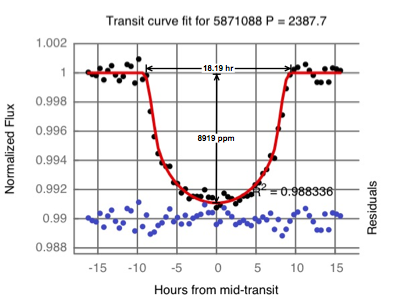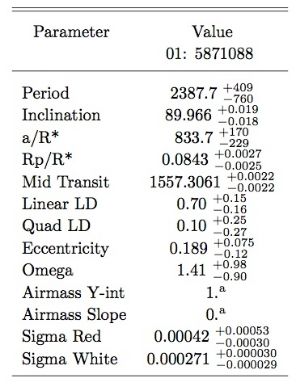Planet Hunters - Kepler Light Curves of Interest
Resurvey of Legacy Kepler Short and Long Cadence Light Curves
Friday, November 9, 2018
An Automated Search for Transiting Exocomets- HD 182952 (KIC 8027456)
A team of astronomers led by Grant M. Kennedy, discovered a potential third comet system in the Kepler prime field data of HD 182952 (KIC 8027456) using an automated search program. As discussed in their recently accepted paper by the Monthly Notices of the Royal Astronomical Society (MNRAS), " we aim to identify asymmetric transits with ingress that is more rapid than egress, as expected for cometary bodies with a significant tail".
Saturday, August 26, 2017
Likely Transiting Exocomets Detected by Kepler by Visual Lightcurve Inspection
KIC 3542116
https://arxiv.org/abs/1708.06069
In January 2017, amateur astronomer Tom Jacobs proposed the idea of visually surveying the complete Q1-Q17 Kepler lightcurve archive spanning 201,250 target stars for Data Release 25 (Thompson et al. 2016) with professional astronomers Saul Rappaport and Andrew Vanderburg along with amateur astronomer Daryll LaCourse. "The survey was conducted using the LcTools software system (Kipping et al. 2015), a publicly available Windows-based set of applications designed for processing lightcurves in a fast and efficient manner. Two primary components from the system were utilized; LcGenerator for building lightcurves in bulk and LcViewer for visually inspecting plots of the lightcurve for signals of interest." Tom Jacobs coordinated with citizen scientist Al Schmitt, author of LcTools, in generating the Kepler prime- field lightcurves in batches of ten thousand.
The team has worked on similar projects with the K2 campaigns. The survey lasted five months with one person (TJ) individually inspecting each lightcurve for interesting objects that were non periodic in nature. There were no predetermined search parameters. Everything was on the table and numerous flagged objects turned out to be data breaks and data processing anomalies (data glitches) upon subsequent analysis by Saul Rappaport and Andrew Vanderburg. Both veterans were indefatigable in supporting the search effort. On March 18th, KIC 35421116 was initially flagged for its three aperiodic transits and subsequently labeled and analyzed as exocomet candidates.

Initially, there was a lot of back and forth discussions on just what the three events were. Concern about data processing anomalies, stellar variability, star dimming (photometric variability), cosmic ray hits (SPSD) and contamination by the neighboring star KIC 3542117 had to be addressed. These concerns were examined in detail and later ruled out as more astronomers, with the specialized expertise, joined the team. Saul Rappaport independently narrowed the possibilities of event type to exocomets due to the asymmetric shapes, shallow depths and lack of clear periodicity. Jon Jenkins successfully advocated for three smaller events in the lightcurve that were eventually considered by the team to be exocomet transits with a possible stellar variability caveat due to their shallow depths and low signal to noise ratio.
Knowing that exocomet-like targets exist in the Kepler data, a second exocomet candidate was flagged in the lightcurve of KIC 11084727 on May 1st, though similar lightcurve profiles would not have been missed during the survey. Attaching an exocomet label to the event proved to be very exciting.

Without the visual survey it is highly unlikely that these two stars would have been flagged even though exhaustive algorithm machine surveys have scoured through the Kepler prime-field data looking for transits over the years. Viewing comet transits in the Kepler data was not thought possible until now and they appear to be rare events likely due to instrument sensitivity and orbit profile viewed by Kepler:
"With regard to the number of comets that should be seen crossing the disk of the host star, this rate should depend heavily on whether the infalling comet orbits are distributed roughly isotropically (lower rate) or if the reservoir of bodies producing the dusty tails has orbits that are coplanar with the angular momentum vector of the system (higher rate if the observer lies in this plane)."
"Present technology does not enable us to view images of these kilometer-size infalling bodies" SETI Institute talk, "Exocomets: Now you see them, now you don't" by Dr. Barry Welsh January 23, 2017.
To date: "Radio observations, in particular detections of circumstellar CO emission around stars such as HD 181327 (Marino et al. 2016), Eta Corvi (Marino et al. 2017), and Fomalhaut (Matra et al. 2017) have been attributed to the presence of substantial populations of minor bodies at large orbital separations. Another sensitive method for detecting and understanding populations of extrasolar minor planets is through time-series spectroscopy, rather than time-series photometry (e.g., as performed by Kepler)."
Exocomet candidates are then said to have been observed indirectly:"Growing evidence for the existence of large populations of extrasolar minor bodies orbiting other stars has come from the detection of anomalous absorption features in the spectra of at least 16 A-type stars where Falling Evaporating Bodies (`FEBs') are proposed to randomly cross the observing line of sight (e.g., Ferlet et al. 1987; Beust et al. 1990; Welsh & Montgomery 2015)."
According to Barry Welsh, "a spectrographic study would clinch their case (Kepler) for comets or show they found rocks and dust" (Wonky Signals from distant stars could be signs of exocomets by Jesse Emspak). What we are now seeing is a possible synergistic blending of observation modalities for validating comets outside our solar system. The upcoming TESS mission may provide more opportunities to observe exocomets and expand our knowledge of these early pristine objects of solar system evolution.
A paper written by a French team in 1999, "Photometric Stellar Variation due to Extra-solar Comets" predicted the detection of exocomets by their dusty tails ( A. Lecavelier des Etangs, A. Vidal-Madjar, and R. Ferlet 1999).
"We performed detailed numerical simulations of stars’ occultations by extra-solar comets. We extracted the apparent photometric variations of the central stars due to these putative comets. We have shown that: 1) Extra-solar comets can be detected through photometric variations due to occultation by dusty tails. In many cases, the light curve shows a very particular “rounded triangular” shape. However, in some remaining cases, the curve can mimic a planetary occultation. 2) The photometric variations due to cometary occultations are mainly achromatic. This property will allow to discriminate the occultations by comets from intrinsic stellar variations. However, the confusion with planetary occultations cannot be efficiently removed by color measurements in the optical. 3) The number of detections which can be expected from a large photometric survey of several tens of thousand of stars at high accuracy (10−4 ) is of the order of several hundreds of occultations per year."
In 2017 we may be seeing their predictions coming true.
Wednesday, January 11, 2017
Resurvey of Kepler Legacy Stars Long and Short Cadence Data
KIC 1028018 LcTools Lightcurve Viewer
Citizen Scientists now have a second chance to survey the Legacy Kepler light curves from their computer den using the free LcTools program by Allan R Schmitt. The light curve resolution is outstanding. This year, using the LcTools generator, the Kepler Long Cadence light curves will be made available as text files in batches of ten thousand stars. Visit Allan R Schmitt's website for the latest release.
Saturday, June 7, 2014
60019950 Possible Planet Transit in Kepler Two-Wheel Engineering Test Data
Graph of Light Curve for 60019950 courtesy of Kian Jek
60019950, 354.9707, 1.98333, 14.8, cool_star
Kian Jek processed the data for this star that reveals two transits that may indicate a grazing planet transit.
Daryll LaCourse:
I took a few minutes to pull up the 60019950 field again. I've extracted light curves from the three neighbor sources at roughly 10, 7 and 4: o'clock, and I see no evidence for these transits/eclipses originating from any of those sources:
Daryll LaCourse:
If anyone wants a taste of what sort of light curves Campaign 0 may deliver, the massive TPFs for these engineering test targets arenow available. In order to extract light curves from them you will need to utilize PyKE (via Ureka bundle is probably the best method) or write your own software.
from the Kepler Blog (emphasis added):
TWO-WHEEL ENGINEERING TEST DATA ONLINEMAR 25, 20149 days of two-wheel engineering data have been delivered to the MAST archive and are accessible to all interested users within the community. This data was collected between Feb 4-13, 2014, before Campaign 0, and points to a different region of sky to Campaign 0, RA = 359 deg, Dec = -2 deg. In future publications and presentations, we would be grateful if you referred to these data collectively as the "Two-wheel Concept Engineering Test". The motivation for delivering this test data is described below.
Campaign 0 is currently underway. Data collection began on Mar 10 and is expected to end on May 30. Campaign 0 is a full end-to-end shakedown test of two-wheel operations. The data collected from Campaign 0 will be processed through the existing Kepler pipeline only as far as the production of Target Pixel Files - small, calibrated and time-tagged images for each target. Further processing of the data, potentially through light curve creation, systematic error mitigation, transit searching and transit characterization is pending operational recommendations and financial decisions from the NASA Senior Review process. Therefore, for data collected during Campaign 0 and the first few potential future campaigns, the scientific community will be far more hands-on in the process of constructing the light curves required to deliver their science goals. Some of the approaches for light curve construction from Kepler Target Pixel Files have been incorporated into the existing PyKE software suite - Simple Aperture Photometry, PSF-fitted photometry and pixel-level Principal Component Analysis. While these Kepler tools will work out of the box for Campaign 0 data, users should note well that the larger spacecraft motion during data collection on two-wheels will mean that the best photometry solutions for Kepler will not necessarily be the best solutions in any future two-wheel operation. The community are encouraged to test the current solutions critically and develop alternatives when necessary. The Kepler Science Center will be turning its attention to these problems also, pending Senior Review endorsement, but the benefits of that effort will not be felt until deeper into the proposed mission.
Therefore to help the community in the endeavor of maximizing photometric quality and precision of a two-wheel mission we have delivered engineering data to the MAST archive. The Kepler spacecraft operated with fine-guidance, collecting data from 2,017 target masks. The properties and quality of the data therein is expected to be similar to those collected during Campaign 0 and provide an excellent opportunity for scientists to make an early and impactful start upon their investigations. Note also that the chances of there being undiscovered planet transits in this engineering set are high and the potential for other serendipitous science is great. To this end we have also provided lists of long cadence and short cadence targets with a brief description of why each was observed during the test. For those investigators eager to develop this test data scientifically and those investigators with the enthusiasm to develop new technical solutions for two-wheel photometry, we encourage you to dive wholeheartedly into this data set. The anonymous ftp address for data download is archive.stsci.edu and the data is archived in folder /pub/k2/tpf_eng. Alternatively there is a URL. A typical file size for one of these target pixel files is 26 MB. The Kepler Science Center will not support this engineering data with future reprocessings, deliveries or new products. However the Kepler Science Center will support questions through the helpdesk regarding this data set on a best-effort basis.
Visit Planet Hunters Talk for more information on analyzing the K2 Engineering test data.
Monday, May 5, 2014
KIC 8681125 Possible Unlisted Planet Candidate at Planet Hunters
Kepler Light Curve KIC 8681125 in Q16 at Planet Hunters
Planet Hunters forum Talk member Kugelbitz flagged this light curve in Kepler Quarter 16 that was subsequently analyzed by veteran Talk members as a viable 5.24 RE planet candidate with two known transits in Q10 and Q16.
Kian Jek:
The first new PC seen in a long time - and just goes to show there are still treasures hidden in the data set even almost a year after Kepler has stopped functioning and moved on to its next mission!
The problem with this target is that although it's situated near the center of the FOV, it lies at the extreme edge of the module, and it's only visible in two out of four of the CCD panels or channels. These correspond to the even quarters and so the odd quarter data are missing.
Because of these large data gaps, one can fit two possible periods to this PC, either 615d or 307.5d.
The two visible transits can be model-fitted to a 615d period transit exceptionally well (see the R2 statistic):
The transit can also be fitted to a 307d period, but this gave an anomalous a/R* of 187.7 vs 375; the latter value is more consistent with the stellar radius and orbital separation wrt period, so the 307d period can be ruled out.
The stellar radius appears to be slightly less than the MAST estimate, to give a Keplerian orbital parameter, approx. ~0.87x Rsol, so based on this, the planetary radius is ~5.24x RE. We will need ground-based follow-up observations to observe a third and confirming transit, this is possible now that we can construct an ephemeris, but it's still going to be challenging as this is a very faint Kp=15 star.You can follow this planet on Planet Hunters forum Talk here.
Saturday, April 26, 2014
K2 Engineering Test Data: Light Curves and Analysis at Planet Hunters
Planet Hunters forum Talk member Daryll LaCourse (Nighthawk_black) has converted all the Kepler Two Engineering Test Data and it is now available online for analysis at Planet Hunters.
Daryll LaCourse:
Daryll LaCourse:
" In early February an engineering test for two-wheel Kepler recorded 9 days of observations for ~2000 stars near Pisces. The original reduction pipeline is not suited to process this batch of data and will need to be overhauled (see this thread for the nitty gritty), but there is still some scientific value here and Martin Still has challenged the community to take a look. I think we should have a go at this! "
To that end I've extracted light curves from all of the available target pixel files using a brute force macro and piece of software available on the GO website called PyKE. The same 15x15 dimension pixel mask was applied on all targets; some have a secondary LC included that is slightly smaller. The complete output batch is 168mb worth of .FITS files and can be downloaded as a single .ZIP archive, or browsed individually.
.ZIP bundle Individual files
A grab bag of previously studied objects, including one confirmed planet hosting star called Wasp-28, were chosen for the target list and the catalog is broken up into the following sections:
EB
SC_target (short cadence)
Variable_Simbad
Multiple_Stars
Hot Stars
Cool Stars
Red Giants
GKM_dwarf
Eng_target
If you have recently joined the team or are a veteran but have previously only used the Classify and PH Talk interfaces, a 3rd party application will be required to look at these new stars. I would recommend downloading both of the following freeware utilities to experiment with:
TOPCAT by Mark Taylor: Stands for 'Tool for OPerations on Catalogues And Tables'. This program consists of a standalone Java file and for the purposes of these light curves it does not matter if you choose the Full or Lite version. Being that the former is only 26mb I would just grab that one. Should work on both Windows and Mac OSX.
LcTools by PlanetHunter Al Schmitt: This is a Windows based lightcurve viewer and signal processor developed for the Kepler project that Al has graciously updated for use with this data set. To install the software, please contact Al at aschmitt@comcast.net . You will notice that LcTools reduces FITs files to a smaller text format via 'LcGenerator'; I've already converted the bundle so it won't be necessary for everyone to do this. Once you have installed the product, just open this additional .ZIP file and follow the Readme.txt instructions.
A few things to consider when hunting around in these light curves:
If you want a particular star redone with a different mask size or a series of them, send me a PM and I will try to accommodate.
- Significant artifacts exist in ~25% or more of these LCs; in some cases the target was not in the center of the mask or more commonly artifacts have corrupted the observations. The former I can go back and fix manually with PyKE, but the latter will require a true dynamic pipeline to address properly. Also note that there are four negative outlier data points in my test files (BJD 1861.91, 1863.87, 1865.83 and 1867.79), so you will need to zoom in past those if using TOPCAT. If using LcTools for browsing, those outliers have been culled away and won't be an issue.
- The extraction masks are large compared to legacy data and applied in a generic fashion, as a result I expect a significant number of LCs have flux from neighboring sources that were blended in. The total degree to which this is going on is tough for me to judge at the moment; some of the point sources here are as dim as 18 while others are as bright as 9 !
- Most if not all of the interesting variables in the first four sections of the catalog are already noted in literature and such information can usually be found with an RA / Dec crosscheck on handy databases like the VSX website,.
- While these '"Two-wheel Concept Engineering Test" files do have EPIC numbers assigned, you will not find them on MAST in the new EPIC catalog area.
Have fun! "
You can visit this thread at Planet Hunters forum Talk and participate in the analysis here.
Wednesday, March 19, 2014
KIC 5871088 Possible Long Period Unlisted Saturn Size Planet
Planet transit in Q16 for KIC 5871088 at Planet Hunters
Planet Hunters forum Talk member Clue4fun4 flagged this transit drop in Kepler Quarter 16. It is a very long period planet that has shown up at the tail end of the Kepler data stream prior to the spacecraft going offline in 2013.
Comments by Kian Jek:
You can follow this planet at Planet Hunters forum Talk page here.
Planet Hunters forum Talk member Clue4fun4 flagged this transit drop in Kepler Quarter 16. It is a very long period planet that has shown up at the tail end of the Kepler data stream prior to the spacecraft going offline in 2013.
Comments by Kian Jek:
This is a very long duration transit that sneaked into the last days of Q16. Eyeballing it, the duration suggests a long period. The primary is a Type K subgiant.
Running a transit fit yields the following:
The period is very long, from 4.4 to 7.7 yr. The planet is approximately the size of Saturn, at 8.11x RE, based on a stellar radius of 0.882x Sol.
You can follow this planet at Planet Hunters forum Talk page here.
Subscribe to:
Comments (Atom)
An Automated Search for Transiting Exocomets- HD 182952 (KIC 8027456)
A team of astronomers led by Grant M. Kennedy , discovered a potential third comet system in the Kepler prime field data of HD 182952 (KIC...

-
Earth size Exomoon orbiting a Saturn- like planet - Wikipedia If an exomoon is going to be observed in the Kepler light curves it will h...
-
There has been lots of exciting news about alien worlds recently with the announcement of confirmation studies for over 41 Kepler exo...
-
Comment by Kian Jek: "So far, Planet Hunters have found three background dwarf novae (DN) candidates in the Kepler public data, and ...














